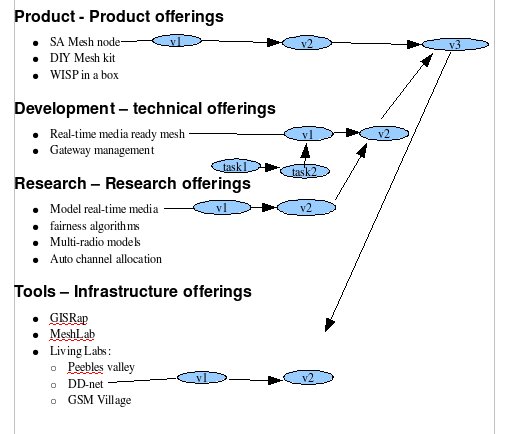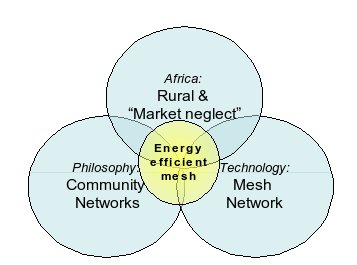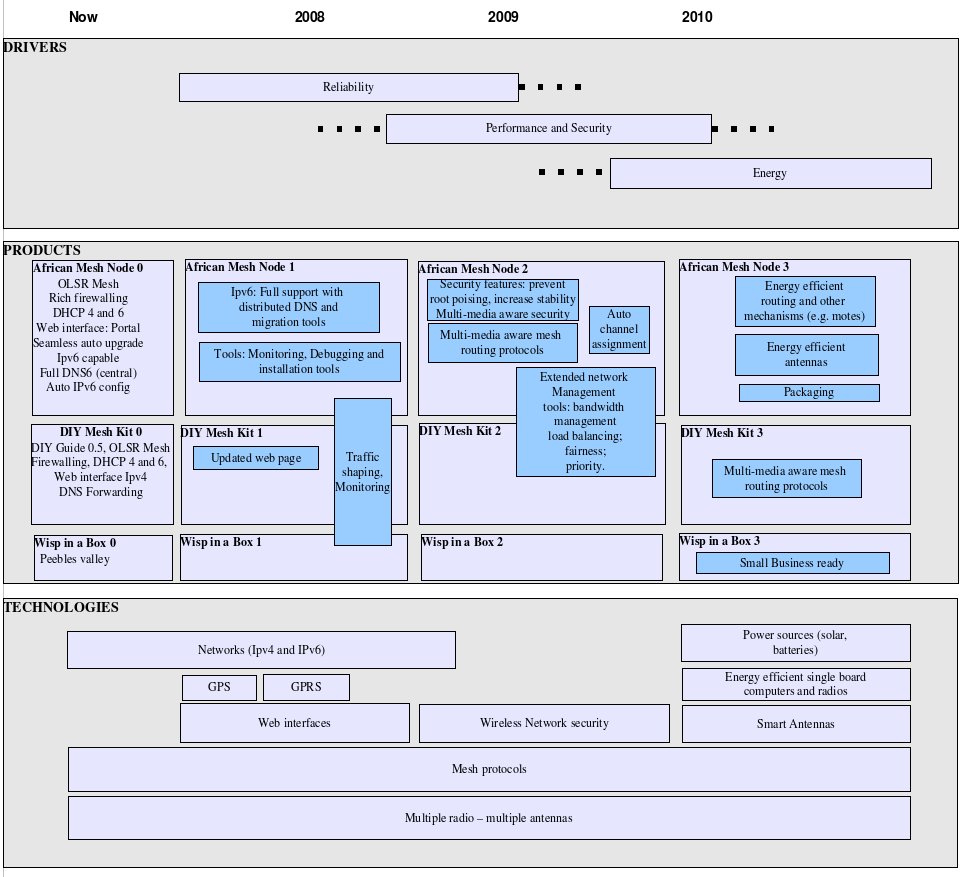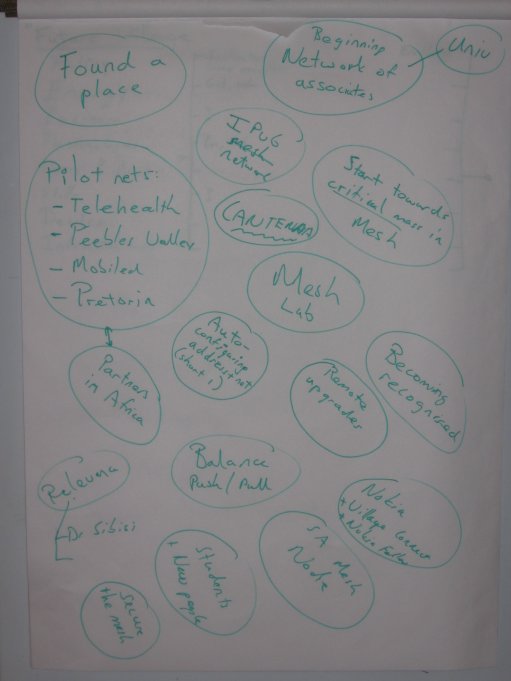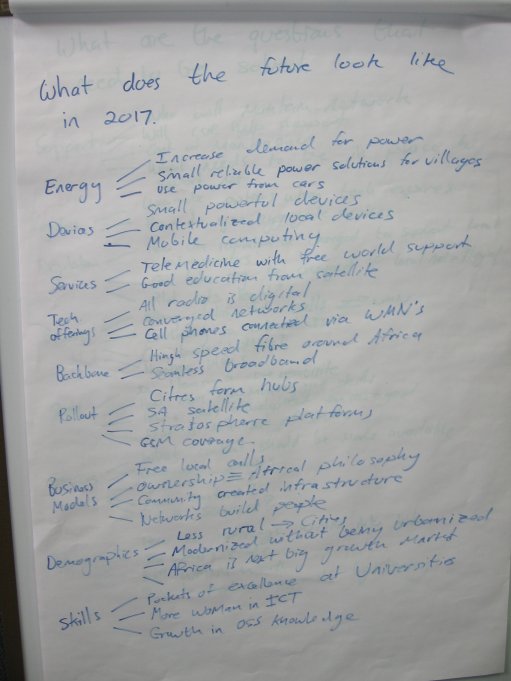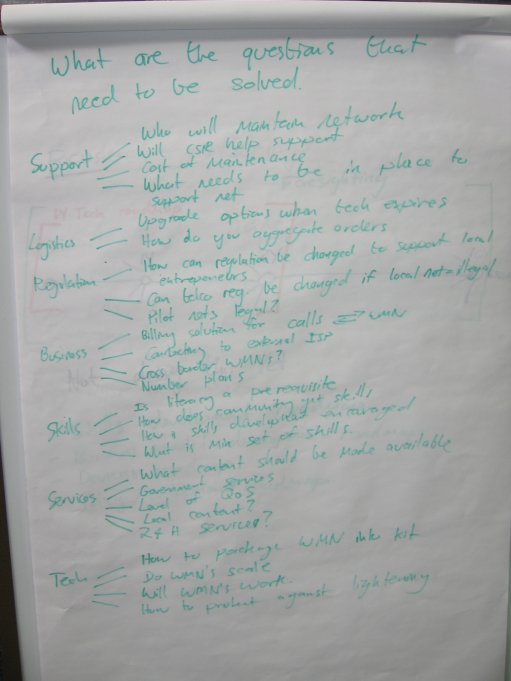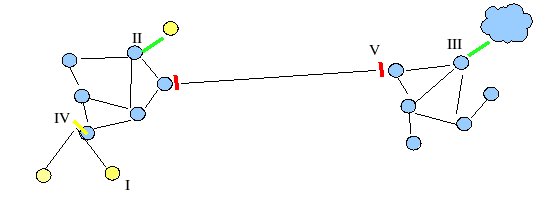Wireless Africa Roadmap
| We had better pay attention to our future, after all it's where we spend the rest of our lives - Albert Einstein |
The road mapping process
- Get synergy on what our product offerings are
- Define “feature sets” of various versions of product offerings within 3 year horizon
- Define Development and Research milestones to contribute to these feature sets
- Define linkages between, research milestones, development milestones and product offering versions
- Define a set of tasks to reach each of the above milestones
- Define what we will be doing this year
The roadmap structure that will be followed
Focus is on a 3 year roadmap
These will be done at another stage
- Skills development roadmap
- Business model development roadmap
- Devices roadmap
- Policy development roadmap
- 10 year foresighting exercise
Our Philosophy and vision
| Vision: Make a significant contribution to connecting 450 million people sustainably in rural Africa through wireless mesh and other technology with a community grown philosophy
|
Our road map so far
Workshop 18th May 2007

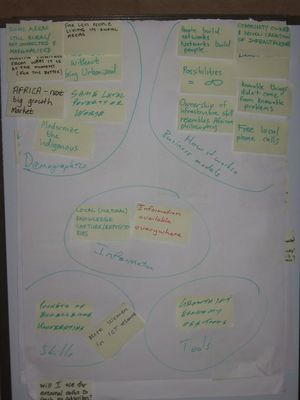
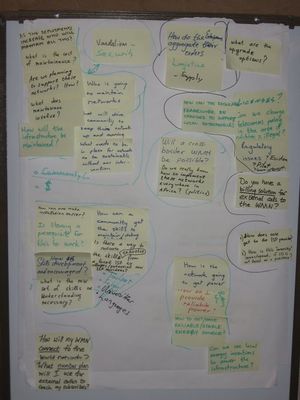
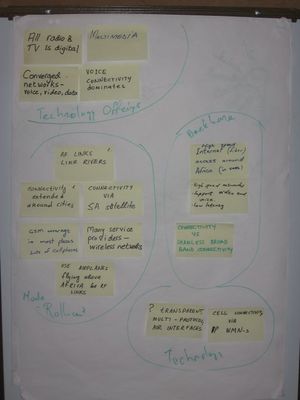
Thinking about what we have achieved
What could the future look like in 2017
What are the questions that need to be answered to connect 450M rural people to the internet
Workshop 8th of June 2007
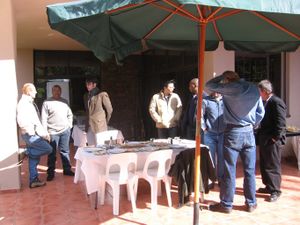
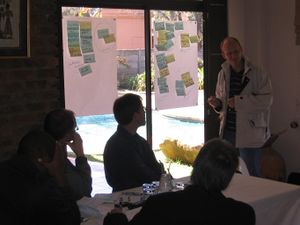

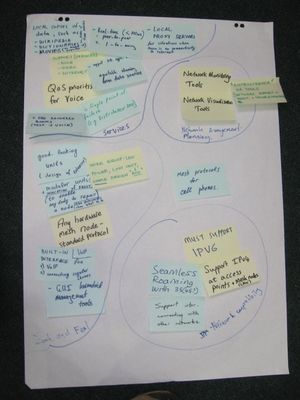
What are our Product Offerings
- Africa mesh node (Multi radio node with customized hardware and specialized firmware)
- Output = Blueprint design, firmware and manual
- Motto = “Mesh as easy to install as radio”
- DIY mesh kit (Low cost single radio node available off the shelf with specialized firmware)
- Output = Firmware and manual
- Motto = “They built a mesh using a download from our website”
- WISP in a box
- Output = Custom OS distribution and manual
- Motto = “I had a wireless business up and running in an hour thanks to WISP in a box”
Remember we will be contributing to these through partnerships with other people
How does the ideal mesh network look
- Network characteristics
- Auto/self config / minimal config required
- Scalable
- Adding nodes increases throughput
- Self healing
- Multi-hop communication
- Standardised mesh routing protocol
- Instant re-routing for VoIP
- Auto hierarchy forming (structured mesh)
- Load balancing protocol
- “intelligent network”
- Self regulating, i.e. (Load balancing, throttling etc)
- Media based network characteristics
- High throughput for video
- High bandwidth, low latency
- VoIP: minimised delay
- Internet: maximum speed
- Low latency for voice
- Energy efficiency
- Low energy consumption
- Load balancing for energy efficiency
- energy aware routing protocol
- Adaptive power usage
- self sustained (own power)
- Services
- Local copies data such as
- Wikipedia
- Dictionaries
- Movies (to make it popular) – even of free movies)
- Real-time (< 100ms)
- peer-to-peer
- 1-to-many
- Local proxy servers: for situation when there is no connectivity to the internet
- Support (services)
- voice
- video
- internet
- Qos priorities for voice
- support database applications
- equitable sharing from data sources
- No single point of failure (e.g. Distributed DNS)
- Pre-recorded books (text + voice)
- Local copies data such as
- Look and feel
- Good looking units (design of exterior)
- node equipment: low power, low cost, simple design “One-box”
- Modular units - indication of faults to enable anybody to repair a node (like photocopier show what to do)
- Any hardware mesh node – standard protocol
- Built-in interface for VoIP, connecting regular phones
- GUI management tools
- Network Management and planning
- Network monitoring tools
- Network Visualization tools
- “Intelligence” via tools (Network support, maintenance and troubleshooting)
- Network capability
- Must support Ipv6
- Support Ipv4 at access points + mesh nodes (LAN)
- Seamless roaming with 3G (4G)
- Support interconnectivity with other networks
- Node Hardware characteristics:
- Easy interfacing
- Easy to install
- Low-cost easy to support or fix
- Easily deployable
- reliable
- provide VoIP
- Easy to join
- Auto config auto update
- environment friendly (RoHS, ...)
- Must be fixable/ expandable by local community
- Environmentally robust/high reliability
- cheap mass production
- simple to build and expand
- Security
- Security is at the edges
- Users are protected from malicious attacks
Understanding the classes of mesh devices
- Class I: A client device
- 1 Radio
- Class II: Infrastructure mesh node (1xDIY or 1xAfrica mesh node)
- 1 to n radios
- Runs routing protocols
- Can have clients connected on its Ethernet interface
- Class III: A gateway node (1xDIY or 1xAfrica mesh node)
- 1 to n radios
- Runs routing protocols
- Has a spare ethernet port to connect to WAN
- Can run some gateway tools / firelwalling etc – but this is usually on a seperate dedicated PC
- Class IV: Cluster head node (2xDIY or 1xAfrica mesh node)
- 2 to n radios (1 radio used to connect one mesh cluster to another)
- Runs routing protocols on both radios
- Class V: A hotspot node (2xDIY or 1xAfrica mesh node)
- 2 to n radios (1 radio dedicated to wirelessly connect clients)
- Runs routing protocols on radio for mesh but may run routing protocols on hotspot radio if clients connecting in ad-hoc mode and forming a client mesh (e.g. OLPC)
- Could run some hotspot tools like chillispot - but this is usually on a separate PC
What is the feature set of an ideal mesh node
Before we build the feature sets of the Africa mesh node or the DIY node, lets think more generically of the feature set of any infrastructure mesh node
- Offers good security (VPN's, backhaul encrypton, firewalling)
- GPS (visualization, location, time synchronization)
- Web interface for management
- Multimedia aware mesh routing
- Offers DHCPv4 and DHCPv6
- Ipv6 capable
- auto IP allocation
- Clients need unique Ipv6 subnets
- Prefix allocation mechanism (possibly from GPS)
- Auto channel allocation (must be 802.11a capable for this)
- Seemless auto upgrade
- Network monitoring software
- DNS – with distributed DNS option
- Should be able to register a host with a dynamic IP
- Auto adjusting power mode
- Uses smart antennas with a routing algorithm to steer/control antennas
- Can offer Ipv4 on an Ipv6 network
- Easy to debug and install
- offers debugging services on the web interface to enable a user to check if a node is down on the network or which node is giving problems
- Many optional parameters on the mesh routing – can optimize for:
- Delay / QoS
- Throughput
- Energy
- Cost
- Can load balance traffic between nodes
- Offers fairness using bandwidth management
- Is able to prioritize traffic (ie essential traffic like routing packets gets priority)
- Has a number of energy features
- Low power mote
- Dynamic transmission power control
What do we have now (i.e. How does version 0 look)
- DIY mesh kit (Version 0)
- OLSR mesh
- Firewalling via command line
- DHCP (Ipv4 and Ipv6)
- Web interface only for Ipv4
- No auto upgrade only upgrade via web interface
- Ipv6 capable but all via command line
- DNS capable but only forwarding (can't register a host)
- Auto configuration (auto IP address in Ipv6)
- Africa mesh node (Version 0)
- OLSR mesh (easy to change to OSPF/RIP via Quagga)
- Rich firewalling via FreeBSD ipfw
- DHCP (Ipv4 and Ipv6)
- Web interface available but no configuration pages created yet
- Seamless distributed auto upgrade option
- Fully Ipv6 capable
- Full DNS capable (can register a host on the mesh device) – but no distributed DNS
- Auto configuration (auto IP address in Ipv6)
- WISP in a box (Version 0)
- Very basic solution for Peebles valley that will do traffic shaping and show monitoring graphs for the network.
3 Year Milestones
Stage 1 (Year 1)
- DIY mesh kit (Version 1.x: document what we have and package existing solutions)
- Minimum required Gateway management tools (traffic shaping, monitoring)
- Africa mesh node (Version 1.x: Aiming towards reliability)
- Monitoring tools (e.g. using GPS, SNMP)
- Ipv6: DHCP6, Prefix allocation, IPv4 over Ipv6 migration tools.
- Debug and Installation tools (web UI)
- Distributed DNS
- Minimum required Gateway management tools (traffic shaping, monitoring)
- WISP in a box (Version 1.x: define requirements, build relationships)
Stage 2 (Year 2)
- DIY mesh kit (Version 2.x: Extend functionality only if resources permits)
- Extended Network management tools (bandwidth management)
- Fairness algorithms
- Priority algorithms
- Africa mesh node (Version 2.x: Aiming towards performance.)
- Security features (e.g. prevent root poisoning, increase stability, internal vs edge security)
- Multimedia-aware mesh routing (add security features to protect against malicious attacks)
- Extended Network management tools (bandwidth management, load balancing over all nodes in mesh)
- Fairness algorithms
- Priority algorithms (essential traffic, graceful degradation)
- Auto-channel assignment
Stage 3 (Year 3)
- DIY mesh kit (Version 3.x: Extend functionality only if resources permits)
- Implement changes in the mesh routing protocols
- Africa mesh node (Version 3.x: Aiming towards energy efficiency.)
- Energy efficiency
- Smart antennas
- Packaging
Next steps (Before the end of July)
- Define technology development milestones which contribute to these feature sets - next step
- Define research milestones which contribute to development milestones or directly to product offerings. Also *Define research milestones which are an end in themselves such as characterising/modelling a mesh network.
- Define linkages between, research milestones, development milestones and product offering versions
- Define a set of tasks to reach each of the research and development milestones.
